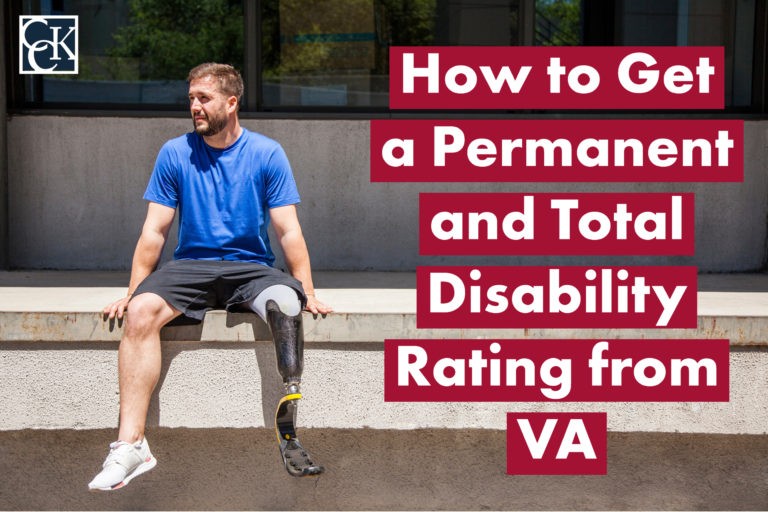How to Get a Permanent and Total Disability Rating from VA

CCK Law: Our Vital Role in Veterans Law
Veterans who are service connected for a disability receive a combined VA disability rating which corresponds to the amount of compensation the veteran will be paid on a monthly basis.
The rating a veteran receives, and the amount of compensation associated with it, is assigned based on the severity of the veteran’s disabilities and the impact their conditions have on their day-to-day life. Generally, the more severe the condition, the higher the rating assigned.
What is a Permanent and Total Disability Rating?
Total Disability
If a veteran is disabled such that they are unable to acquire or maintain gainful employment due to a service-connected disability or disabilities, VA will assign a total disability rating of 100 percent. A total disability rating is assigned to veterans with one service-connected condition rated at 100 percent, multiple disabilities whose ratings combine to 100 percent, or to those eligible for Total Disability based on Individual Unemployability (TDIU).
Permanent Disability
A permanent VA disability means VA has found that the severity of the disability is expected to continue for the remainder of the veteran’s life, with no improvement. Those considered to be “totally” disabled are not automatically considered “permanently” disabled as well.
Permanent and Total Disability
VA does not require those assigned a permanent and total disability rating to undergo any further medical examinations. If you are only considered to be “totally disabled,” VA will likely request follow-up medical exams in the future to check on the status of your condition. If a veteran is considered “permanently” disabled (such as a single amputation), VA will not require a follow-up exam.
VA assumes that veterans assigned a permanent and total (P&T) disability rating will have to live with a severely debilitating service-connected condition, or the residuals of one, for the rest of their lives. In turn, these veterans will also receive VA compensation for the rest of their lives.

Examples of Permanent and Total Disabilities
Below are some examples of disabilities which could be eligible for permanent and total ratings:
- ALS (Lou Gehrig’s Disease)
- Amputation of both hands
- Amputation of both feet
- Amputation of hand and one foot
- Loss of sight in both eyes
- Traumatic Brain Injury
Can a Permanent and Total Rating Be Reduced?
Rating reductions can reduce the amount of monthly compensation the veteran receives. Permanent and total ratings can be very beneficial for veterans, as they are protected from reductions. As reductions are often a cause of worry in many veterans, those who are granted permanent and total ratings may feel more at ease knowing that their benefits will not be reduced.
What are the Requirements for Permanent and Total Ratings?
In order to be eligible for a Permanent and Total disability rating, the veteran will need to indicate to VA that they have a severe disability that cannot improve.
How to Prove Eligibility for Permanent and Total Ratings
- Establishing Service-Connected Disability
In order to be awarded a Permanent and Total rating, veterans must first be service connected for a disability. More specifically, the disability must be considered severe enough by VA to warrant a permanent rating.
Conditions which do not warrant high ratings, such as tinnitus which is granted a maximum rating of 10 percent, will not be eligible for a Permanent and Total rating. However, service connection for a condition like ALS, which can cause neurons in the muscles to die and weakened muscle function, would be eligible for a Permanent and Total disability rating. Establishing service connection is a key first step in the road to being awarded a Permanent and Total rating.
- Proving the Condition Will Not Improve
The other integral part of eligibility for a Permanent and Total rating is indicating that the veteran’s condition will not improve. In certain situations, like with amputation of a body part, it is obvious that the condition will not improve; however, it may be more difficult to indicate that other types of conditions will not improve.
Key evidence to indicate this can include any form of medical evidence from doctors, psychologists, neurologists, cardiologists, or oncologists. The medical evidence should indicate that the veteran’s condition will not improve over time.
For example, if the veteran is service connected for a debilitating traumatic brain injury (TBI), then medical evidence from a neurologist can indicate that the brain cannot heal itself and the symptoms will never improve. Certain evidence may include brain scans, other forms of imaging scans, or functioning tests. The evidence can indicate to VA that the veteran’s traumatic brain injury is severe and extensive to the point where the veteran will not recover, and their symptoms will not improve.
How to Check if You Have a Permanent and Total Rating
Sometimes, a veteran may be unaware that they have a Permanent and Total VA disability rating. Conversely, some veterans may think that they have a Permanent and Total rating when, in reality, they do not, meaning they are still subject to possible rating reductions.
The best way to determine whether you have a Permanent and Total disability rating is to look at your VA Rating Decision letter. This is the letter which is mailed to you informing you of the rating percentage you have been assigned for your service-connected disability. Veterans can also log in to their eBenefits portal to view their VA Benefit Summary letter, which can also help inform them if they have a Permanent and Total Rating.
To determine if the rating is Permanent and Total, veterans will need to look at the letter in the “VA Benefit Information” section. This section will have a statement that reads: “You are considered to be totally and permanently disabled due solely to your service-connected disabilities.” Beside the statement, it will either read yes or no. If the word yes is there, then the veteran’s rating is Permanent and Total.

Additional Benefits for Veterans with Permanent and Total Disability Ratings
There are numerous benefits available to veterans who have been granted a Permanent and Total rating. Below are some examples of the benefits available to veterans once they have received a Permanent and Total rating.
DIC Benefits
Permanent and Total ratings can offer some benefits for surviving spouses in some instances. For example, if a veteran has been rated with a Permanent and Total for at least ten years, then the veterans widow will be eligible for Dependency and Indemnity Compensation.
Healthcare Benefits
Veterans who have a Permanent and Total rating are eligible for the highest priority group that VA offers for health care benefits.
CHAMPVA Health Insurance for Spouse and Dependent Children
The Civilian Health and Medical Program of the Department of Veterans Affairs (CHAMPVA) is a health benefits program in which VA shares the cost of certain health care services and supplies with eligible beneficiaries, such as spouses and dependent children.
DEA Benefits
DEA benefits are educational benefits available to the spouse and children of veterans who have a permanent and total rating. Specifically, the benefits consist of a monthly stipend for the children of veterans who are enrolled full-time in school.
TDIU and Permanent and Total Ratings
Total disability based on individual unemployability is a monthly benefit that pays veterans who are unable to work because of their service-connected at the 100 percent compensation level. Many veterans who experience mental and physical disabilities as the result of their service are eligible for TDIU benefits if they cannot work because of these disabilities.
Specifically, there are two forms of TDIU: schedular and extraschedular.
In order to be eligible for Schedular TDIU, veterans must have one condition rated at 60 percent minimum OR two conditions that can be combined to reach 70 percent, where one condition is rated at a minimum of 40 percent. The criteria for schedular TDIU is outlined under 38 CFR § 4.16a.
Veterans who do not meet the necessary criteria for schedular TDIU may be eligible for extraschedular TDIU. For this form of TDIU, veterans must prove that their condition(s) uniquely hinders their ability to maintain substantially gainful employment. Extraschedular TDIU is rated under 38 CFR § 4.16b.

TDIU can be very beneficial for veterans who are unable to work, but do not have a 100 percent rating, as this benefit allows them to be compensated at the 100 percent level. However, if a veteran is already rated at the 100 percent level, they will not receive any additional benefits for TDIU. In other words, if a veteran has already been awarded a Permanent and Total rating, pursuing TDIU will not result in any more compensation for the veteran. This is because the veteran is already receiving payment at the 100 percent rating level due to their Permanent and Total rating.
Have Questions About Permanent and Total Disability Ratings?
The nature of Permanent and Total ratings can be very confusing. Many veterans do not know if they have a Permanent and Total rating, or if they are protected from rating reductions. Additionally, it can be extremely hard to win claims for Permanent and Total ratings since the criteria can be so stringent. If you need help getting the Permanent and Total rating you are seeking, our office may be able to help. The experienced veterans’ advocates at Chisholm Chishom & Kilpatrick have helped veterans win their appeals for Permanent and Total ratings and we may be able to help you too. Contact our office today for a free case review.
About the Author
Share this Post
